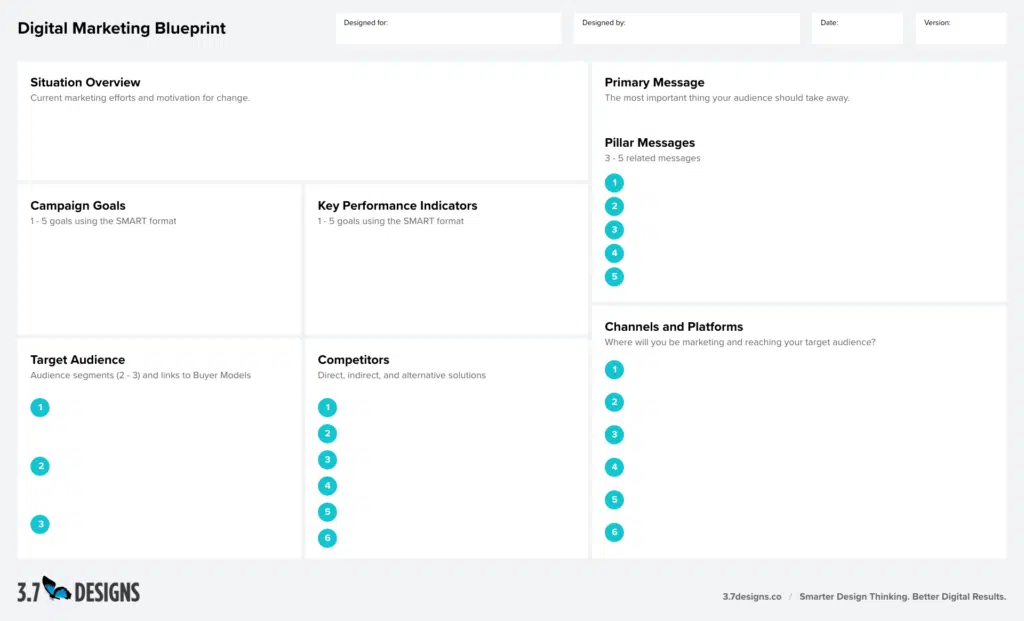Crafting a Winning Digital Marketing Blueprint [Free Download]

The success of your digital marketing efforts will directly relate to the quality of your planning. A well-researched and thought-out plan guides the most effective campaigns with the greatest return on investment. Digital marketing is complicated and multifaceted; you can’t simply “wing it” and expect good results.
In short, you need a digital marketing blueprint to be successful.
This article will cover the eight pillars of an effective digital marketing blueprint. In the end, you can download our “Digital Marketing Blueprint Canvas,” a free resource that you can use to guide and document your blueprint.
Let’s start by defining what a digital marketing blueprint is. Unlike a comprehensive digital marketing strategy that can span 20+ pages of detailed information, a digital marketing blueprint is a simple, one- to two-page document. It outlines only the most essential elements of your strategy—concise, easy to understand, and focused on the critical details.
The eight digital marketing blueprint pillars are:
- Situation Overview
- Campaign Goals
- Key Performance Indicators
- Target Audience
- Competitive Analysis
- Messaging
- Channels and Platforms
- Content Strategy
Let’s dive into each one.
Situation Overview
If you don’t know where you are, it’s hard to determine where to go.
Every blueprint should start with an overview of the current situation. This ensures anyone reading the document has the context to understand the initiative. This can be a brief paragraph explaining your current marketing efforts and motivation for change.
Campaign Goals
You’ll likely end up somewhere else if you don’t know where you want to go.
You might think this step is unnecessary; after all, aren’t all marketing campaigns focused on building awareness and driving sales for products and services?
This is the most essential step in the process. Without clear and actionable goals, you won’t be able to focus your efforts and will likely waste time and resources.
We recommend using the SMART goal format, an acronym for Specific, Measurable, Achievable, Relevant, and Time-Bound. This structure turns vague and unactionable goals like “Market our products or services” into clarity-building directions like “Increase product sales by 25% in six months.”
We recommend limiting the number of goals to 3 – 4 to prevent spreading your efforts too thin.
Key Performance Indicators (KPIs)
Goals clarify what you’re trying to accomplish. Key performance indicators (KPIs) measure your progress in achieving goals.
Simply put, KPIs are metrics you define to track your success toward a given goal. If your goal is to build brand awareness, how will you determine whether your efforts are successful?
Each goal should have at least one KPI; however, you might find that two or three should be used in conjunction. For example, brand awareness could be measured by monthly branded search volume, social media followers, and social mentions.
It’s OK to have qualitative KPIs, where instead of a quantitiave metric, you’re measuring the general impression of a given audience. For example, if you’re measuring brand perception, you might survey your target audience with open-ended questions rather than having them rate your brand attributes on a 1 – 5 scale.
Target Audience
The better you understand who you’re trying to reach, the easier it will be to reach (and motivate) them.
If you could only complete two portions of the digital marketing blueprint, it should be campaign goals and audience research.
There are many ways to learn about your target audience, including customer interviews, sales team interviews, field research, focus groups, etc. As you learn more about your target audience, it’s important to analyze and document your findings in an easy-to-digest format. Traditionally, you’d create “buyer personas,” but we recommend creating more robust “buyer models.”
Understanding your target audience’s goals, challenges, behaviors, motivations, and thought processes will directly inform where you’ll market and what messages you communicate.
Competitive Analysis
In most cases, your audience will be considering multiple options. You have direct and indirect competitors and alternative solutions. For example, a digital marketing agency competes with other digital agencies (direct), traditional marketing agencies (indirect), and in-house teams (alternative solution).
If you understand your strengths, weaknesses, opportunities, and threats (SWOT) you can tailor your messaging to highlight your strengths, address / minimize your weaknesses, and stand out as the best solution.
This understanding is obtained by analyzing your competitors. Competitive analysis can also uncover the strategies that are working for your competitors that you can leverage and improve upon.
Messaging
You now have the background necessary to define your messaging. Messaging is the simple and memorable ideas you want to communicate to your target audience.
Communication is the center of marketing. Articles, social posts, advertisements, web pages, and emails are different communication forms. The question is, what do you want your target audience to know? What do they want to know?
Your messaging should tell your target audience how to best solve their problem and why you’re different (and better) than everyone else.
Your prior research has uncovered your target audience’s goals, motivations, thought processes, and what makes you different. You just need to synthesize that information into a concise message.
We recommend identifying your primary message first. This is the most important thing you want your target audience to take away. From there you can break it down into 3 – 5 “pillar messages.”
For example, our primary message is “We will make you a hero of your organization.” Our supporting pillar messages are:
- Strategic inbound marketing campaigns that drive leads and sales
- Delightful digital experiences that engage your target audience
- An enjoyable and collaborative working relationship
- Being your external success advocate
All marketing communication should reference your primary and pillar messages. It takes 8 – 10 exposures before we remember a message, so it’s important to reiterate it at every stage despite sounding repetitive.
Channels and Platforms
Now, it’s time to be more tactical. Where and how will you reach your target audience? In the B2B space, there are numerous channels you can leverage to reach your ICP (ideal customer profile.) The more common channels include:
- Paid or organic social media
- Paid or organic search
- Email and marketing automation
- Webinars
- Podcasts
- Video channels
Your audience research should identify where they spend their time and the buying process, which will inform your decisions. Do they spend time on Linkedin? Do they do online research before making big decisions? If so, you’re probably looking at organic and paid LinkedIn and Search Engine Marketing.
Things to consider are the level of effort and budget. Organic social media posting can be a high-effort, long-term investment, requiring no ad spend. Social advertising, on the other hand, is low-effort but generally more expensive.
At this early stage, it’s worth exploring more channels and platforms to test the effectiveness of each.
Content Strategy
Each channel or platform requires content, such as social posts, articles, videos, emails, web pages, etc.
Your content strategy outlines what content exists, what content needs to be created, who will create it, and by when.
Start by evaluating your messaging and determining what content you already have that you can use or modify. Then, identify where you have gaps. Finally, create a content calendar outlining when and where content will be posted, when content will be created, and by who.
This will serve as your working roadmap to execute your digital marketing blueprint.
Digital Marketing Blueprint Canvas
We created a simple, easy-to-use canvas to guide and document all critical aspects of a practical digital marketing blueprint. Download it below to communicate your digital marketing plan to your team in a simple, easy-to-digest format.

Wrapping Up
A solid plan is critical for success, whether a small or large business or your goals are lead generation or brand awareness. The effort you invest into a digital marketing blueprint will pay back tenfold.
Learn more about our capabilities if you need help with your digital marketing blueprint. We’re a B2B technology marketing agency that helps marketing and sales leaders identify the most effective way to approach their digital marketing campaigns. We’d love to help you, too.